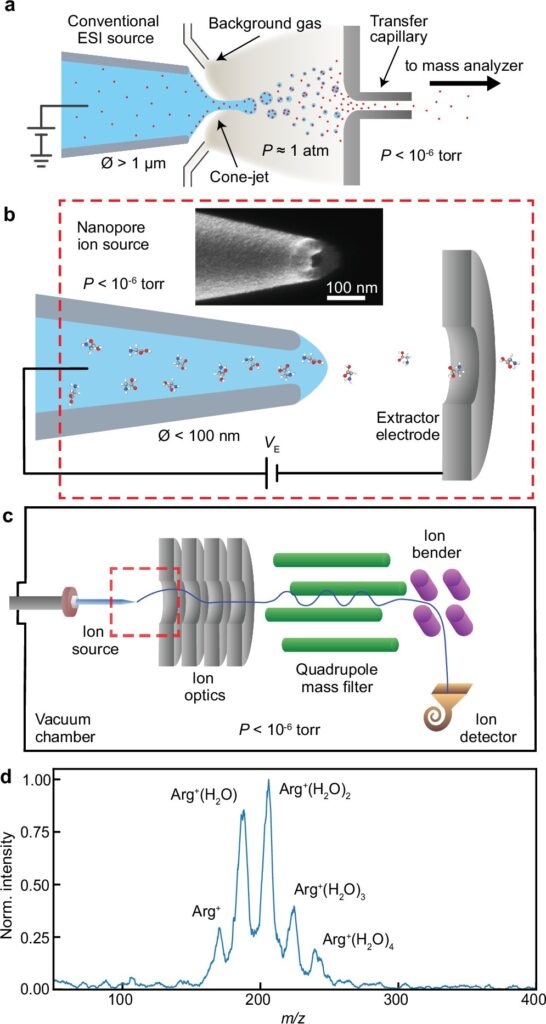Mass spectrometry is a powerful technique that allows scientists to break down and identify the building blocks of just about anything by measuring the mass of the tiny particles of which something is comprised. It has a major limitation, however—about 99% of the sample being measured is typically lost before analysis even begins.
This rate of loss hampers the technology’s potential. It reduces accuracy and sensitivity, wastes resources and complicates sample preparation, which can lead to additional errors. That might not be the case much longer, though.
A research team from Brown University has developed a new method for transferring the ions that mass spectrometers analyze, dramatically reducing sample loss so nearly all of it remains intact.
“The conventional technique for producing ions for mass spectrometry, called electrospray ionization, basically involves a very sharp needle getting placed just in front of the mass spectrometer, hitting it with an electric field that pulls out a spray of charged droplets that eventually dry out to produce bare ions that make it into the mass spectrometer from open air,” said Nicholas Drachman, a physics Ph.D. student at Brown who led the work.
“Basically, it’s a process where you’re really spraying your sample all over the place to produce these ions and only get a tiny portion of them into the mass spectrometer’s vacuum for analysis. Our approach skips all of that.”
Called a nanopore ion source, the advancement overcomes a longstanding logjam in science and has the potential to revolutionize mass spectrometry technology. The Brown team describes the novel innovation in Nature Communications.
The key is a tiny capillary the researchers developed that has an opening about 30 nanometers across—roughly 1,000 times smaller than the width of a human hair. For comparison, the conventional needle used in electrospray has an opening of about 20 micrometers across, which is about 600 times bigger than the tube developed at Brown.
The new nanotube also has the unique ability to transfer ions that are dissolved in water directly into the vacuum of a mass spectrometer, rather than producing a spray of droplets that must be dried out to access the ions.
In addition, conventional mass spectrometers typically draw in a significant amount of gas along with the ions during the process, necessitating several stages of vacuum pumps to pull in the ions. The new breakthrough means that gas won’t need to be pumped out, because it won’t get sucked in, according to the researchers.
“Rather than place it in front of a mass spectrometer and generate this spray of droplets, we just place it directly into the mass spectrometer, skipping this messy spray, drying and vacuum process,” Drachman said. “By generating ions in the vacuum directly, it drastically reduces the pumping requirements, which should significantly simplify the complex hardware of mass spectrometers.”
The Brown team was inspired by nanopore sequencing in DNA and envisions commercializing their idea for widespread use by protein researchers, including for the long-sought goal of sequencing proteins one amino acid at a time.
“Mass spectrometry is the best way to look at proteins, which are made up of amino acids that have all sorts of different chemical and physical properties, because it can tell them apart by the mass of their ions with high certainty,” said Derek Stein, a professor of physics at Brown and author on the paper.
“Proteomics has not seen the same advances as genomics in the last two decades, and so there’s been this hunger for a technology that can improve analysis of proteins. By getting rid of that sample loss problem, it should enable these much more sensitive analyses to be possible, like sequencing the amino acids in a protein molecule one-by-one and in sequential order. This is the blue-sky idea that has motivated our work.”
The team spent the past 10 years working on the new method. They started by custom designing their own mass spectrometer that could house the unique ion source in a vacuum, unlike traditional designs where the ion source is separate from the device and sits in open air.
The team built the key component of their transfer device by using a special machine to heat a glass tube in the middle and then delicately pull it apart to create an extremely small opening at the tip invisible to the naked eye.
Trial and error played a significant role in the process, often leading to weeks of frustration as they worked to get everything functioning consistently at the tip of the capillary, which is far too tiny to inspect by eye.
“There were some weeks we didn’t know if we were cursed by God himself or something—things just stopped working,” Stein said. “Other weeks, everything worked brilliantly.”
The team’s persistence paid off. They successfully demonstrated that ion analysis with their new transfer method matches detections done using traditional methods but with far less sample loss, offering a more efficient and accurate way to analyze tiny particles.
“We needed to convince people in the proteomics field that we can generate the same kind of ions that they are used to generating by conventional electrospray—and that we can do it in this different and, we believe, better way,” Drachman said.
The analysis described in the paper serves as a proof of concept for the method. Next, the researchers aim to unlock the full potential of their nanopore ion source.
“We need to show that this can improve the workflow of proteomic analyses,” Drachman said. “We’d like to take that to the next level and make it something that will improve the science of researchers throughout the field.”


